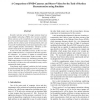Free Online Productivity Tools
i2Speak
i2Symbol
i2OCR
iTex2Img
iWeb2Print
iWeb2Shot
i2Type
iPdf2Split
iPdf2Merge
i2Bopomofo
i2Arabic
i2Style
i2Image
i2PDF
iLatex2Rtf
Sci2ools
82
Voted
CVPR
2007
IEEE
2007
IEEE
A Comparison of PMD-Cameras and Stereo-Vision for the Task of Surface Reconstruction using Patchlets
Recently real-time active 3D range cameras based on time-of-flight technology (PMD) have become available. Those cameras can be considered as a competing technique for stereo-vision based surface reconstruction. Since those systems directly yield accurate 3d measurements, they can be used for benchmarking vision based approaches, especially in highly dynamic environments. Therefore, a comparative study of the two approaches is relevant. In this work the achievable accuracy of the two techniques, PMD and stereo, is compared on the basis of patchlet estimation. As patchlet we define an oriented small planar 3d patch with associated surface normal. Leastsquares estimation schemes for estimating patchlets from PMD range images as well as from a pair of stereo images are derived. It is shown, how the achivable accuracy can be estimated for both systems. Experiments under optimal conditions for both systems are performed and the achievable accuracies are compared. It has been found that t...
| Added | 02 Jun 2010 |
| Updated | 02 Jun 2010 |
| Type | Conference |
| Year | 2007 |
| Where | CVPR |
| Authors | Christian Beder, Bogumil Bartczak, Reinhard Koch |
Comments (0)

